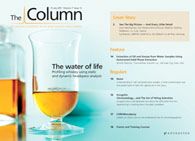Nanoscale bone analysis
Researchers at Rensselaer Polytechnic Institute in New York, USA, have developed a new technique that allows researchers to collect large amounts of biochemical information from nanoscale bone samples.

Researchers at Rensselaer Polytechnic Institute in New York, USA, have developed a new technique that allows researchers to collect large amounts of biochemical information from nanoscale bone samples.1
Limitations in sample availability and high heterogeneity of bone tissue can cause unique experimental and diagnostic problems. To address this, researchers developed a method that combines a laser‑capture microdissection method of fully mineralized bone tissue with several new UHPLC methods for the determination of advanced glycation end products in proteins. This method, in addition to hierarchical separation of bone-matrix proteins using 2D SDS-PAGE, and a combination of these techniques with mass spectrometric analysis, yields data about the concentration of different proteins in the bone matrix, which in turn leads to key information about the bones.
“We’re able to take very small, nanoscale-sized bone samples, and determine the protein signatures of the bone,” said Deepak Vashishth, head of the Department of Biomedical Engineering at Rensselaer. “This is a relatively quick, easy way for us to determine the history of the bone — how and when it formed — as well as the quality of the bone, and its likelihood to fracture.”
Along with adding important new insights into the fight against osteoporosis, this innovation opens up new proteomics‑based approaches to analysing bone quality and could also aid the archeological and forensic study of human skeletons.
1. G.E. Sroga et al., Mol. Cell Proteomics, (In press).
This story originally appeared in The Column. Click here to view that issue.
New Method Explored for the Detection of CECs in Crops Irrigated with Contaminated Water
April 30th 2025This new study presents a validated QuEChERS–LC-MS/MS method for detecting eight persistent, mobile, and toxic substances in escarole, tomatoes, and tomato leaves irrigated with contaminated water.
University of Tasmania Researchers Explore Haloacetic Acid Determiniation in Water with capLC–MS
April 29th 2025Haloacetic acid detection has become important when analyzing drinking and swimming pool water. University of Tasmania researchers have begun applying capillary liquid chromatography as a means of detecting these substances.

.png&w=3840&q=75)

.png&w=3840&q=75)



.png&w=3840&q=75)



.png&w=3840&q=75)









